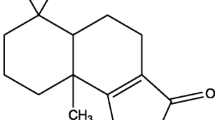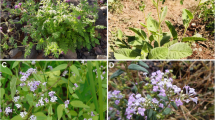Abstract
The larvicidal, behavioral, and morphological response of dengue vector, Aedes aegypti treated with deleterious weed, Argemone mexicana, was explored. The 1,000 ppm extracts of A. mexicana leaf, stem, and roots prepared in five different solvents (petroleum ether, hexane, benzene, acetone, and ethanol) were screened for their larvicidal activity against dengue vector establishing the efficacy of petroleum ether and hexane extracts. Other extracts, unable to give 100 % mortality, were considered ineffective and discarded from further study. Larvicidal bioassay conducted with selected extracts confirmed the higher efficacy of hexane extracts exhibiting 1.1- to 1.8-fold more potential than the petroleum ether extracts. The results further revealed 1.6- to 2.4-fold higher efficacy of root extracts than those prepared from the leaves and stem of A. mexicana. The hexane root extract of A. mexicana was found to be the most effective larvicide with LC50 value of 91.331 ppm after 24 h of exposure causing 1.8 and 2.4 fold more toxicity as compared to the hexane leaf and stem extracts, respectively. Prolonged exposure of the larvae to the extracts resulted in increased toxicity potential of the extracts. Observations of the treated larvae revealed excitation, violent vertical, and horizontal movements with aggressive anal biting behavior suggesting effect of extracts on their neuromuscular system. Morphological studies of the treated larvae revealed the demelanization of cuticle and shrinkage of internal cuticle of anal papillae indicating the anal papillae as the probable action sites of the A. mexicana extracts. The potential of A. mexicana as new larvicides against dengue vector are being explored.





Similar content being viewed by others
References
Abbott WB (1925) A method for computing the effectiveness of an insecticide. J Econ Entomol 18:265–267
Alagesaboopathi C (2009) Ethnomedicinal plants and their utilization by villagers in Kumaragiri hills of Salem district of Tamil Nadu, India. Afr J Tradit Complement Altern Med 6:222–227
Amer A, Mehlhorn H (2006a) Persistency of larvicidal effects of plant oil extracts under different storage conditions. Parasitol Res 99:473–477
Amer A, Mehlhorn H (2006b) Repellency effect of forty-one essential oils against Aedes, Anopheles and Culex mosquitoes. Parasitol Res 99:478–490
Becker N, Petric D, Zqomba M, Boase C, Madon M, Dahl C, Kaiser A (2010) Mosquitoes and their control, 2nd edn. Springer, New York, pp 409–599
Chaithong U, Choochote W, Kamsuk K, Jitpakdi A, Tippawangkosol P, Chaiyasit D, Champakaew D, Tuetun B, Pitasawat B (2006) Larvicidal effect of pepper plants on Aedes aegypti (L.) (Diptera: Culicidae). J Vector Ecol 31:138–143
Choochote W, Tuetun B, Kanjanapothi D, Rattanachanpichai E, Chaithong U, Chaiwong P, Jitpakdi A, Tippawangkosol P, Riyong D, Pitasawat B (2004) Potential of crude seed extract of celery, Apium graveolens L., against the mosquito Aedes aegypti (L.) (Diptera: Culicidae). J Vector Ecol 29:340–346
Choochote W, Chaiyasit D, Kanjanapothi D, Rattanachanpichai E, Jitpakdi A, Tuetun B, Pitasawat B (2005) Chemical composition and antimosquito potential of rhizome extract and volatile oil derived from Curcuma aromatica against Aedes aegypti (Diptera: Culicidae). J Vector Ecol 30:302–309
Clements AN (1992) The biology of mosquitoes, vol 1: Development, nutrition and reproduction. Chapman and Hall, London
Dharmagadda VSS, Naik SN, Mittal PK, Vasudevan P (2005) Larvicidal activity of Tagetes patula essential oil against three mosquito species. Biores Technol 96:1235–1240
Garrett M, Bradley TJ (1984) The pattern of osmotic regulation in larvae of the mosquito Culiseta inornata. J Exp Biol 113:133–141
Insun D, Choochote W, Jitpakdi A, Chaithong U, Tippawangkosol P, Pitasawat B (1999) Possible site of action of Kaempferia galanga in killing Culex quinquefasciatus larvae. Southeast Asian J Trop Med Publ Hlth 30:195–199
Jirakanjanakit N, Rongnoparut P, Saengtharatip S, Chareonviriyaphap T, Duchon S, Bellec C, Yoksan S (2007) Insecticide susceptible/resistance status in Aedes (Stegomyia) aegypti and Aedes (Stegomyia) albopictus (Diptera: Culicidae) in Thailand during 2003–2005. J Econ Entomol 100:545–550
Kumar S, Warikoo R, Wahab N (2010) Larvicidal potential of ethanolic extracts of dried fruits of three species of peppercorns against different instars of an Indian strain of dengue fever mosquito, Aedes aegypti L. (Diptera: Culicidae). Parasitol Res 107:901–907
Kumar S, Singh AP, Nair G, Batra S, Seth A, Wahab N, Warikoo R (2011a) Impact of Parthenium hysterophorus leaf extracts on the fecundity, fertility and behavioural response of Aedes aegypti L. Parasitol Res 108:853–859
Kumar S, Warikoo R, Misha M, Seth A, Wahab N (2011b) Larvicidal efficacy of the Citrus limetta peel extracts against Indian strains of Anopheles stephensi Liston and Aedes aegypti L. Parasitol Res 111:173–178
Kumar S, Wahab N, Mishra M, Warikoo R (2012a) Evaluation of 15 local plant species as larvicidal agents against an Indian strain of dengue fever mosquito, Aedes aegypti L. (Diptera: Culicidae). Front Physiol 3:1–6
Kumar S, Nair G, Singh AP, Batra S, Wahab N, Warikoo R (2012b) Evaluation of the larvicidal efficiency of stem, roots and leaves of the weed, Parthenium hysterophorus (Family: Asteraceae) against Aedes aegypti L. Asian Pac J Trop Dis 2:395–400
Lima EP, Paiva MSH, de Araújo AP, da Silva EVG, de Oliveira LN, Santana AEG, Barbosa CN, de Paiva Neto CC, Goulart MO, Wilding CS, Ayres CFJ, de Melo Santos MA (2011) Insecticide resistance in Aedes aegypti populations from Ceará, Brazil. Parasites Vectors 4:5
National Vector Borne Disease Control Programme (NVBDCP) (2013) Dengue cases and deaths in the country since 2007.http://nvbdcp.gov.in/den-cd.html. Accessed 7 June 2013.
Rahuman AA, Gopalakrishnan G, Venkatesan P, Geetha K, Bagavan A (2008a) Mosquito larvicidal activity of isolated compounds from the rhizome of Zingiber officinale. Phytother Res 22:1035–1039
Priya CL, Rao KVB (2012) Ethanobotanical and current ethanopharmacological aspects of Argemone mexicana Linn: an overview. Int J Pharma Sc Res 3:2143–2148
Rahuman AA, Gopalakrishnan G, Venkatesan P, Geetha K (2008b) Isolation and identification of mosquito larvicidal compound from Abutilon indicum (Linn.) Sweet. Parasitol Res 102:981–988
Rahuman AA, Gopalakrishnan G, Venkatesan P, Geetha K (2007) Larvicidal activity of some Euphorbiaceae plant extracts aginst Aedes aegypti and Culex quinquefasciatus (Diptera: Culicidae). Parasitol Res 102:867–873
Raj Mohan D, Ramaswamy M (2007) Evaluation of larvicidal activity of the leaf extract of a weed plant, Ageratina adenophora, against two important species of mosquitoes, Aedes aegypti and Culex quinquefasciatus. Afr J Biotechnol 6:631–638
Rawani A, Mallick Haldar K, Ghosh A, Chandra G (2009) Larvicidal activities of three plants against filarial vector Culex quinquefasciatus Say (Diptera: Culicidae). Parasitol Res 105:1411–1417
Sakthivadivel M, Thilagavathy D (2003) Larvicidal and chemosterilant activity of the acetone fraction of petroleum ether extract from Argemone mexicana L. seed. Biores Tech 89:213–216
Sakthivadivel M, Thilagavathy D (2008) Evaluation of certain insecticidal plants for the control of vector mosquitoes viz. Culex quinquefasciatus, Anopheles stephensi and Aedes aegypti. Appl Entomol Zool 43:57–63
Sarwar M, Ahmad N, Toufiq M (2009) Host plant resistance relationships in chickpea (Cicer arietinum L.) against gram pod borer (Helicoverpa armigera Hubner). Pak J Bot 41:3047–3052
Sathish M, Maneemegalai S (2008) Evaluation of larvicidal effect of Lantana camara Linn against mosquito species Aedes aegypti and Culex quinquefasciatus. Adv Bio Res 2:39–43
Warikoo R, Wahab N, Kumar S (2011) Larvicidal potential of commercially available pine (Pinus longifolia) and cinnamon (Cinnamomum zeylanicum) oils against an Indian strain of dengue fever mosquito, Aedes aegypti L. (Diptera: Culicidae). Acta Entomol Sin 54:793–798
World Health Organization (2005) Guidelines for laboratory and field testing of mosquito larvicides. WHO, Geneva
World Health Organization (WHO) (2012) Dengue and severe dengue. http://www.who.int/mediacentre/factsheets/fs117/en/. Accessed 11 June 2013
Acknowledgments
The authors are highly grateful to University Grants Commission, New Delhi for providing research fellowship to carry out the present investigations. Thanks are extended to Dr. Savithri Singh, Principal, Acharya Narendra Dev College for providing infrastructure and research facilities.
Author information
Authors and Affiliations
Corresponding author
Rights and permissions
About this article
Cite this article
Warikoo, R., Kumar, S. Impact of Argemone mexicana extracts on the cidal, morphological, and behavioral response of dengue vector, Aedes aegypti L. (Diptera: Culicidae). Parasitol Res 112, 3477–3484 (2013). https://doi.org/10.1007/s00436-013-3528-7
Received:
Accepted:
Published:
Issue Date:
DOI: https://doi.org/10.1007/s00436-013-3528-7




